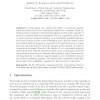Free Online Productivity Tools
i2Speak
i2Symbol
i2OCR
iTex2Img
iWeb2Print
iWeb2Shot
i2Type
iPdf2Split
iPdf2Merge
i2Bopomofo
i2Arabic
i2Style
i2Image
i2PDF
iLatex2Rtf
Sci2ools
123
Voted
ADHOCNOW
2008
Springer
2008
Springer
A Lower Bound on the Capacity of Wireless Ad Hoc Networks with Cooperating Nodes
In this paper, we consider the effects on network capacity when the nodes of an ad hoc network are allowed to cooperate. These results are then compared to the theoretical upper bound on the capacity of an ad hoc network without cooperation. For our cooperative model, two or more nodes are grouped together to cooperatively transmit information from the source node to the destination node. Here the lower bound is presented without frequency reuse and it is found that node cooperation can only help improve network capacity as the number of nodes in cooperation increases. However, the results of our cooperative network model show that without frequency reuse, node cooperation could not out perform a peer-to-peer network with frequency reuse. Furthermore, the improvement of network capacity might not be worthwhile beyond two nodes cooperating together. The three-node cooperation yields minimum gain, if not negligible, compared to the two-node cooperation.
Related Content
| Added | 08 Nov 2010 |
| Updated | 08 Nov 2010 |
| Type | Conference |
| Year | 2008 |
| Where | ADHOCNOW |
| Authors | Anthony S. Acampora, Louisa Pui Sum Ip |
Comments (0)

